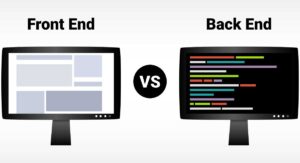Every successful software or app owes its quality to code review. This process ensures that the app is reliable, efficient, and bug-free. As a result, the software is less likely to crash, performs better, and provides a smoother, more satisfying experience for users.
The best code review environments balance a positive feedback culture while prioritizing meeting the necessary standards. Code review best practices play a crucial role in achieving this balance.
This article will discuss the best practices for code review. But before that, we will briefly define code review and its qualities.
If you want to learn more about code review and other essential developer skills, stay tuned to the end, where we discuss an expert-led full stack web development course.
What is Code Review?
A code review, or a peer review, is the practice of reviewing codes written by developers to improve the quality, identify bugs, detect potential risks and opportunities for enhancing or simplifying the code, and assist developers in understanding the source code. It is conducted by senior personnel with sufficient experience who can be objective in the review.
Code review is a methodical quality assurance technique that helps confirm that the code satisfies its requirements and is error-free before merging and shipping it. Simply put, code review is the editing process of a code. It can be iterative to ensure that the code has been improved as recommended during one code review cycle.
By establishing clear guidelines for conducting code reviews, teams can ensure that feedback is constructive, respectful, and focused on improving code quality.
Also Read: What is White Box Testing? Definition, Types, Features, and Benefits
Top Qualities of Good Code Reviews
A good code review ensures that the code has been sufficiently evaluated and the suggestions for improvement have been implemented. Here are some top qualities distinguishing a good code review from an average one.
- The objectives of the code review are clarified to the developers before the process
- The code review is conducted professionally and respectfully to improve the code rather than nitpick the developer’s skills
- The details of the code review, suggestions, and subsequent improvements are sufficiently documented and made accessible to all concerned parties
- The personnel selected for the code review have experience in the domain of the code and are open to collaboration if necessary
- The final code review and delivery timelines are clearly defined and regularly tracked
- Code review of simpler parts is automated so that the reviewer can dive deep into the more intricate parts of the code
- The code review is consistent with the organization’s processes, standards, and previous code reviews. Any standard modifications are sufficiently documented and implemented in subsequent code reviews.
Tips: Code Review Best Practices
Here are the top ten best practices for streamlining the code review process and preventing it from becoming an endless loop of review and change.
Establish the objectives and metrics and create a checklist
Before starting the review, clarify its purpose and how you will judge the code’s quality. This sets clear review objectives and ensures developers understand the code standards and requirements. Define metrics like bug count, inspection rate, and improvements to track progress objectively and create a checklist for the review to ensure all code aspects are covered. The checklist can consist of questions such as:
- Are there areas that can expose the system to a data breach?
- Is the code readable?
- Does the code require additional test cases?
Keep the review time short
Long review periods can be counterproductive. In sessions that last more than an hour, reviewers often miss some bugs, reducing the overall efficiency of the review.
Additionally, long reviews can be overwhelming, making it challenging to absorb numerous comments, particularly those delivered verbally.
It’s way more effective to break up the code review into short time slots, each lasting 45-60 minutes. This will give the developer time to understand the feedback and assess the code before making the final changes while ensuring the enthusiasm and productivity of the review are sustained.
Also Read: The 10 Best Software Testing Tools in 2024
Limit the number of code lines reviewed
Similar to the second point, define the number of lines to be reviewed per session. It should not be too much or too little. For example, spending 40 minutes on ten lines of code is as unproductive as racing through 1000 lines in 30 minutes.
Hence, determine the optimum number of lines and stick to it. Typically, a code reviewer can efficiently detect bugs in 200 lines of code at a time. If they review more than 200 lines, they cannot maintain the same rate of bug identification in the subsequent code.
As a result, some flaws in the code after 200 lines may be overlooked. Aim for incremental changes and avoid drastic modifications unless necessary.
Group similar modifications
Sometimes, a developer may make similar mistakes throughout the code. At such times, you can identify an error and mark the areas where similar errors exist in the rest of the code.
This will prevent repetition, and the developer can make all the changes in the same phase. For example, if you need to refactor a class, the code reviewer can make the areas for the refactoring and review them together, even if they do not occur in the same code lines.
Fix a process for bug correction
If you suggest different approaches for fixing different bugs, developers may require clarification, potentially leading to unaddressed issues. Therefore, it’s important to establish specific steps for fixing each bug, adapting the approach based on its type and complexity. A consistent process for each bug helps developers track their progress in resolving the issues.
Ensure source code annotation
Code review should be easily understood by developers and other reviewers. An effective method is to annotate the source code before the review. These annotations serve as a guide, helping reviewers prioritize files and understand the rationale behind the prioritization. Additionally, developers can review the annotation guide to check the feedback provided. This annotation also aids other reviewers in catching up on previous reviews and avoids duplication of comments.
Set clear distinction between approved and requested changes
After a review is completed, the reviewer may choose to approve some changes while retaining some comments that do not affect the overall functioning of the code. In such cases, use the correct comment type to indicate the status, such as ‘Approved,’ ‘Requested,’ ‘Not yet approved,’ etc.
If certain parts of the code have open-ended questions, only approve the changes with clarification. A follow-up review may address some comments. If there are urgent changes, you can make them to save time and release the code quicker. Strive to modify a code to an acceptance and avoid rejections as far as possible.
Assess the test code
Test code consists of test cases used to assess the actual code. You can mentally form a model of how the code works. So, if you begin the review by evaluating the test code, the issues with the code can be quickly detected. You will be able to pinpoint the operational problems that can occur during the code operation.
You can then proceed to the main code to evaluate other errors that may not be obvious in the test cases. Thus, you can get a test code of superlative quality. This reduces manual testing and post-production flaws while improving the code’s maintainability.
Avoid bias in code review
While code reviews aim to be objective, unintentional bias and partiality can sometimes influence the process. This is especially true when the reviewer is an expert in a specific domain, which can lead to a focus on domain-specific errors and potentially overlook critical flaws in other areas. Conversely, reviewers with extensive domain experience may have strong opinions that can inadvertently influence their evaluation, potentially leading to overlooking better solutions.
You must know your expertise relative to the code you’re reviewing to mitigate bias. Strive to maintain an open mind, consider alternative perspectives, and be willing to adapt your approach based on the specific context of the code under review.
Build personal interaction with the developers
Effective review and feedback require a deep understanding of your developers’ skills.
Take the time to view the code from their perspective and explain changes in a way that resonates with them. Keep communication open for disagreements, allowing developers to discuss why certain changes may or may not be feasible and explore alternative options.
Written comments can sometimes appear more critical than intended. Thus, explaining comments face-to-face can ensure that the intended message is conveyed accurately.
Also Read: System Testing in Software Testing: Definition, Types, and Tips
Learn Code Review Best Practices and Other Essential Web Development Skills
Code review is crucial for delivering applications without errors. It requires understanding the review process and web development fundamentals. Only with this knowledge can you identify areas needing improvement while building software and apps.
To gain this understanding, consider this full stack web development bootcamp. It covers key concepts such as Agile and Scrum methodologies, version control systems, SQL, and front-end and back-end technologies. The expert-led, interactive classes will equip you with skills like containerization, Spring Core 50, Servlets, Hibernate, and JPA.
Our program offers the opportunity to work on Capstone projects using tools like Jenkins, Git, Angular, Docker, Maven, and JUnit 5. This practical experience, guided by industry veterans, can significantly boost your career.
You might also like to read:
Clean Code Principles: Enhancing Software Quality and Maintainability
A Comprehensive Guide to Black Box Testing
Breaking Down the Types of Software Testing






